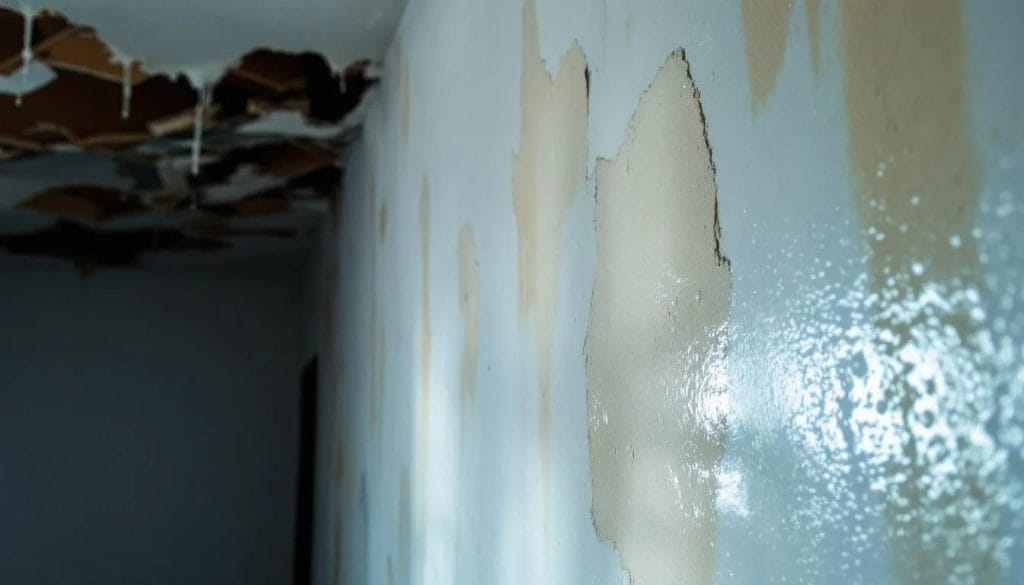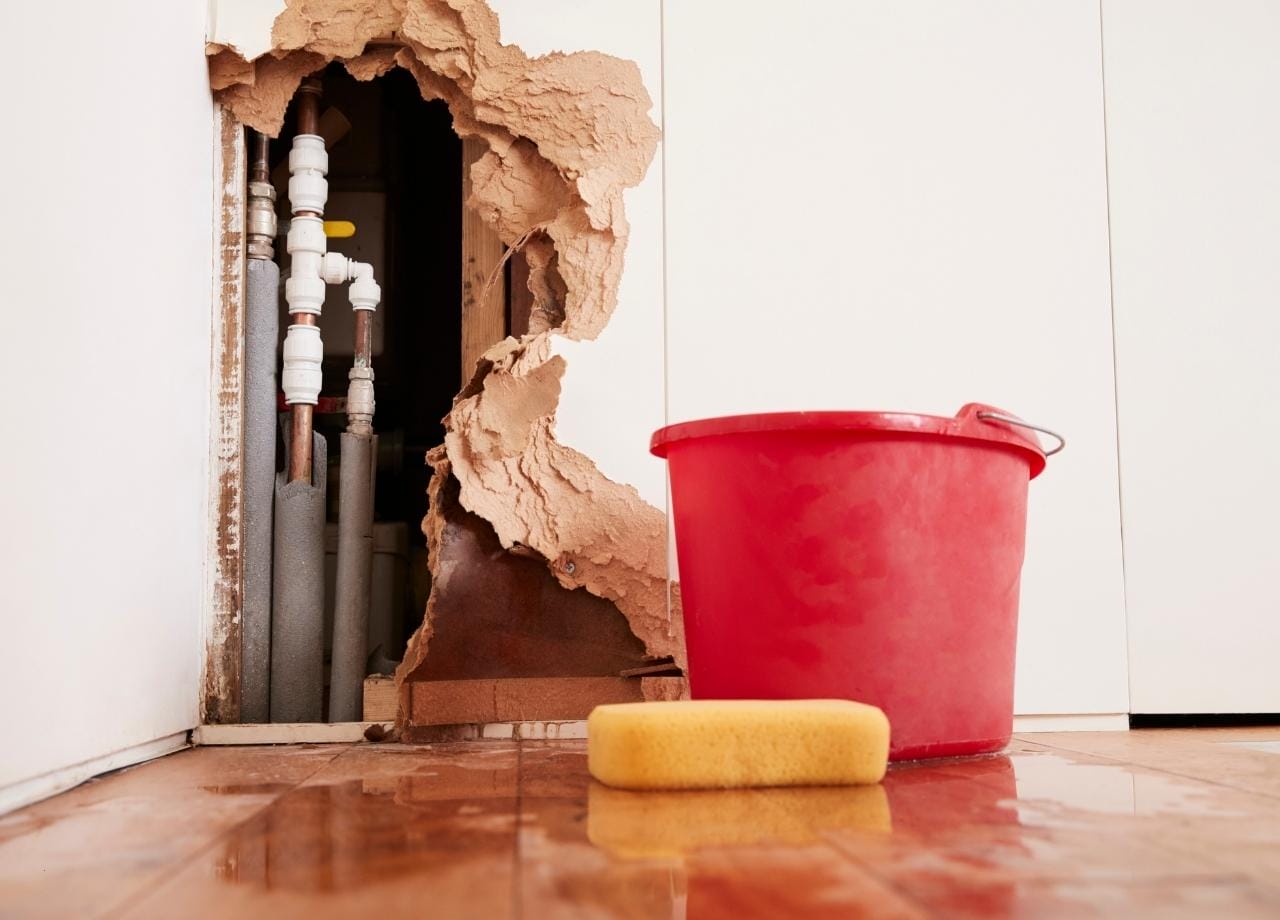Water damage that occurs behind walls can go unnoticed for months, even years. By the time visible signs appear, the structural integrity of the wall may already be compromised. In Jacksonville, St. Augustine, and surrounding areas, high humidity, seasonal storms, and older home construction make hidden water damage a common issue. At First Coast Contracting, we often encounter this type of damage during restoration or remodeling projects and have the expertise to properly address it before it leads to more serious problems.
Recognizing hidden water damage early can prevent costly repairs and health hazards like mold growth. Here are the main warning signs every homeowner should watch for.
Table of Contents
Unusual or Musty Odors That Don’t Go Away
One of the earliest indicators of water damage is a persistent musty smell. Even if you can’t see mold or mildew, trapped moisture behind drywall or paneling creates the ideal conditions for microbial growth. These odors typically don’t respond to air fresheners or cleaning products because they stem from inside the walls. If your home has a lingering damp smell in a specific area, especially near plumbing, consider it a red flag.
Warped or Buckled Walls and Baseboards
When drywall absorbs water, it loses its rigidity. Over time, this can lead to bubbling, soft spots, or sections that appear swollen or misshapen.
Baseboards may start to pull away from the wall or develop a wave-like appearance. These changes don’t happen instantly but develop gradually as water infiltrates the wall cavity. If a wall surface that used to be smooth now looks uneven or warped, moisture may be trapped inside.
Stains or Discoloration That Keep Spreading
Discoloration on walls or ceilings usually signals past or ongoing water exposure. Unlike surface dirt, water stains often appear yellow, brown, or copper-toned and continue to spread. If you paint over a stain and it reappears or grows larger, moisture is still present. In bathrooms, kitchens, or near HVAC systems, this can also be a sign of a slow leak.

Peeling or Bubbling Paint and Wallpaper
Moisture behind a wall disrupts the adhesion of paint and wallpaper. When water builds up, the surface finish may blister, peel, or separate from the drywall underneath. In some cases, wallpaper may begin to sag or bubble out in patches. These surface irregularities are often mistakenly dismissed as poor workmanship when the real issue is hidden water intrusion.
Unexpected Spikes in Utility Bills
If your water bill increases without a change in usage, you could be dealing with a leak inside the wall. Small pinhole leaks in copper or plastic pipes can waste hundreds of gallons per month without any visible puddles or drips. Likewise, long-standing leaks from HVAC lines or water heaters may not trigger alarms until damage is extensive.
Presence of Mold in Unusual Areas
Mold thrives in dark, damp places. If you find mold or mildew in areas that aren’t typically wet—like behind furniture, around electrical outlets, or along interior walls away from plumbing—you may have water seeping in where it shouldn’t be. Mold growth is more than just a cosmetic problem; it signals that the internal environment of your walls has shifted due to moisture.
Soft or Spongy Spots When Pressing on Walls
Drywall should feel solid. If you press gently on a wall and it feels soft, spongy, or gives under pressure, the material has likely absorbed water. These spots may appear sound from the outside but have started to break down internally. Tapping on the wall may also produce a hollow or uneven sound, which is another sign of hidden damage.
Cracking or Separation at Wall and Ceiling Joints
Water-damaged framing can swell, shift, or deteriorate, leading to cracks in drywall or separation at joints. This is especially noticeable where walls meet ceilings or at corner seams. While small hairline cracks are common in older homes, wider or expanding cracks can point to something more serious lurking inside the wall.
Condensation or Dampness Without Obvious Cause
If walls feel damp or you notice moisture beads forming on surfaces during normal weather conditions, it suggests high humidity or a leak within the wall. Dry interiors should not feel humid unless there’s an external cause. If you use a dehumidifier and the problem returns quickly, something internal could be feeding that moisture.
Noisy Plumbing or Sounds From Inside Walls
Hissing, dripping, or gurgling sounds coming from inside the walls often indicate a hidden leak. In some cases, water escaping under pressure will make a tapping or knocking sound, especially when fixtures aren’t in use. These noises are often faint and intermittent but should not be ignored.
What Causes Water Damage Behind Walls
There are a few common causes behind water infiltration into wall cavities:
- Leaking or burst pipes due to corrosion, poor installation, or freezing temperatures
- Faulty or aging plumbing connections, particularly in older homes
- Roof leaks that travel down wall framing
- Window or door leaks from failed seals or flashing
- Clogged gutters allowing water to back up into siding and framing
- HVAC condensation lines that overflow or drain improperly
- Improperly sealed tubs, showers, or backsplashes
In coastal Florida, water intrusion is also exacerbated by heavy rains, hurricane conditions, and shifting foundations, all of which can cause building materials to expand, crack, or separate.
Why Hidden Water Damage Shouldn’t Be Ignored
Moisture behind walls does more than discolor drywall. It can weaken the structure of your home, promote mold growth, and create health risks for your family. Wood framing that stays wet will eventually rot, attracting termites and other pests. Insulation can become saturated, losing its effectiveness and harboring mildew. Left untreated, what begins as a small leak can lead to full-scale demolition and rebuild.

Homeowners insurance may cover water damage from sudden events like burst pipes but often excludes damage caused by slow leaks or poor maintenance. Acting quickly can make the difference between a covered repair and a denied claim.
How to Detect Hidden Water Damage Early
While some signs are visible, many require special tools to confirm. Moisture meters, thermal imaging cameras, and borescopes allow restoration professionals to see inside walls without immediate demolition. If you suspect hidden water damage, a professional assessment is the safest next step.
Don’t rely solely on visual clues. Seasonal inspections of plumbing, attic spaces, and areas around windows and doors can help catch issues before they escalate. If you’ve had water intrusion before, monitor those spots more closely.
Final Thoughts
Hidden water damage behind walls is one of the most expensive types of home repairs because of the labor involved in identifying and fixing the issue. By learning the warning signs and understanding what to look for, you can take action before a small leak becomes a structural nightmare.
First Coast Contracting offers professional moisture detection, restoration, and remodeling services across Northeast Florida. If you’re seeing any of these signs or need a second opinion, our team can help pinpoint the problem and provide a repair plan that restores safety, comfort, and peace of mind to your home.


